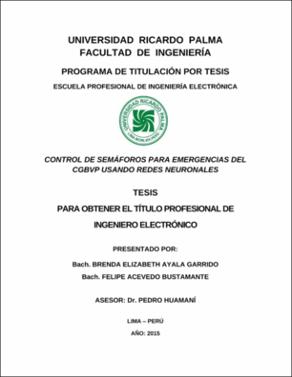| dc.contributor.advisor | Huamaní Navarrete, Pedro Freddy | |
| dc.contributor.author | Ayala Garrido, Brenda Elizabeth | |
| dc.contributor.author | Acevedo Bustamante, Felipe | |
| dc.date.accessioned | 2019-08-08T21:28:31Z | |
| dc.date.available | 2019-08-08T21:28:31Z | |
| dc.date.issued | 2015 | |
| dc.identifier.uri | https://hdl.handle.net/20.500.14138/2140 | |
| dc.description.abstract | La presente tesis, tuvo como objetivo mostrar una estrategia a través de redes neuronales, para los vehículos del Cuerpo General de Bomberos Voluntarios del Perú (CGBVP) durante una emergencia en el distrito de Surco, contribuyendo a la fluidez vehicular de las unidades en situaciones de emergencia. A nivel mundial se puede apreciar que se han desarrollado diferentes estrategias o sistemas que apoyan a las unidades de emergencia. El desarrollo del sistema propuesto consiste en preparar los semáforos con anticipación al paso de una unidad. Para ello se consideraron dos tipos de datos, ubicación y dirección, con el fin de activar los semáforos tiempo antes que el vehículo llegue a la intersección. El presente estudio analizó la red Neuronal LVQ (Learning Vector Quantization) y 2 tipos de red Backpropagation con el fin de determinar cuál de ellas es la más adecuada para el caso propuesto. Finalmente a través de simulaciones se determinó la red Backpropagation [100 85 10] obtuvo mejores resultados, siendo el de regresión igual a 0.99 y presentando valores de error en un rango de 10^-5 o menores. El algoritmo por Backpropagation [100 85 10] demostró durante sus 3 simulaciones responder correctamente a los 3 escenarios planteados. Demostrando únicamente variaciones pequeñas durante las simulaciones pero ninguna superando valores aceptables de 0 o 1 lógico. The following thesis had as objective to show a strategy using neural networks to help vehicles of the fire fighter brigade in Peru (CGBVP) during emergencies on the district of Surco, helping with the response times of the unit on emergency situations. Worldwide can be seen that strategies or systems are being used to help lower the problems of traffic. The development of the proposed system consist on preparing the traffic lights previous the arrival of the unit to the intersection. For this 2 type of data is being considered, location and direction, in order to activate the lights time before the vehicle arrives to the intersection. The present study analyzed the LVQ (Learning Vector Quantization) and 2 types of backpropagation networks in order to determine which of them is the most fitting for the situation to handle. Finally, going through the simulations it was determined that the [100 85 10] backpropagation network had the best response, being the regression 0.99 and showing error on the range of 10^-5 or lowers. The algorithm by backpropagation [100 85 10] showed during the 3 simulations that works property on all 3 situations. It showed small variations on some of the simulations but nothing out of the acceptable values of a logic 1 or 0. | es_ES |
| dc.description.sponsorship | Submitted by Robert Alexander Campos Rivas (robert.c.rivas@gmail.com) on 2019-08-08T21:28:31Z
No. of bitstreams: 1
acevedo_f-ayala_be.pdf: 1601703 bytes, checksum: d32a8450fa3f0ae3fa2acf6ab037b08b (MD5) | es_ES |
| dc.description.sponsorship | Made available in DSpace on 2019-08-08T21:28:31Z (GMT). No. of bitstreams: 1
acevedo_f-ayala_be.pdf: 1601703 bytes, checksum: d32a8450fa3f0ae3fa2acf6ab037b08b (MD5)
Previous issue date: 2015 | es_ES |
| dc.description.uri | Tesis | es_ES |
| dc.format | application/pdf | |
| dc.language.iso | spa | |
| dc.publisher | Universidad Ricardo Palma - URP | es_ES |
| dc.rights | info:eu-repo/semantics/openAccess | |
| dc.rights.uri | https://creativecommons.org/licenses/by-nc-nd/4.0/ | |
| dc.source | Repositorio Institucional - URP | es_ES |
| dc.subject | LVQ (Learning Vector Quantization) | es_ES |
| dc.subject | Control de semáforos | es_ES |
| dc.subject | Redes neuronales | es_ES |
| dc.title | Control de semáforos para emergencias del Cuerpo General de Bomberos Voluntarios del Perú usando redes neuronales | es_ES |
| dc.type | info:eu-repo/semantics/bachelorThesis | |
| thesis.degree.discipline | Ingeniería Electrónica | es_ES |
| thesis.degree.grantor | Universidad Ricardo Palma. Facultad de Ingeniería. Escuela Profesional de Ingeniería Electrónica | es_ES |
| thesis.degree.level | Título Profesional | es_ES |
| thesis.degree.program | Programa de Titulación por Tesis | es_ES |
| thesis.degree.name | Ingeniero Electrónico | es_ES |
| dc.publisher.country | PE | es_ES |
| dc.subject.ocde | https://purl.org/pe-repo/ocde/ford#2.02.00 | |
| renati.type | https://purl.org/pe-repo/renati/type#tesis | |
| renati.level | https://purl.org/pe-repo/renati/nivel#tituloProfesional | |
| renati.discipline | 712026 | |
| dc.type.version | info:eu-repo/semantics/publishedVersion | |


